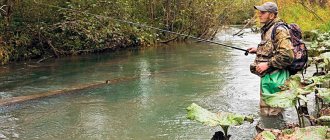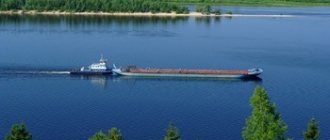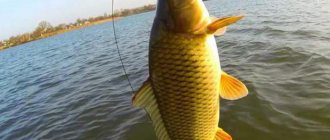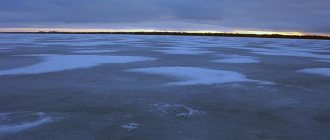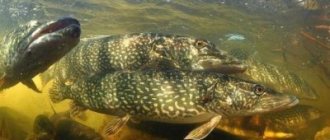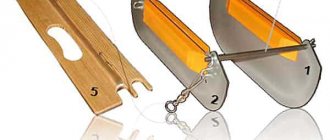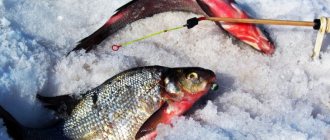deutschenglishespañolfrançaisहिन्दी
Fishing forecast > Russia > Tyumen region > Tyumen district > Karmak
Find out how the fish are biting in the Carmack River in the coming days. The bite forecast takes into account the weather, moon phase, water temperature, and seasonal fish activity.
Carmack River on the map:
Expand the map
to zoom with the mouse wheel
Move this checkbox
| February 16 Tuesday | February 17 Wednesday | February 18 Thursday | February 19 Friday | February 20 Saturday | ||||||||||||||||
| time | night 02:00 | morning 08:00 | day 14:00 | evening 20:00 | night 02:00 | morning 08:00 | day 14:00 | evening 20:00 | night 02:00 | morning 08:00 | day 14:00 | evening 20:00 | night 02:00 | morning 08:00 | day 14:00 | evening 20:00 | night 02:00 | morning 08:00 | day 14:00 | evening 20:00 |
| Weather show weather hide weather | Partly cloudy | Haze | Mainly cloudy | Mainly cloudy | Partly cloudy | Partly cloudy | Mainly cloudy | Haze | Haze | Haze | Mainly cloudy | Haze | Mainly cloudy | Haze | Mainly cloudy | Supercooled fog | Supercooled fog | Haze | Mainly cloudy | Supercooled fog |
| air temperature, °C °F feels like, °C °F | −19 -2° | −22 -8° | −17 1° | −18 -0° | −21 -6° | −25 -13° | −21 -6° | −20 -4° | −22 -8° | −24 -11° | −19 -2° | −19 -2° | −22 -8° | −25 -13° | −24 -11° | −25 -13° | −30 -22° | −30 -22° | −22 -8° | −22 -8° |
| −26 -15° | −28 -18° | −24 -11° | −25 -13° | −30 -22° | −34 -29° | −30 -22° | −26 -15° | −28 -18° | −24 -11° | −26 -15° | −30 -22° | −34 -29° | −33 -27° | −32 -26° | −34 -29° | −34 -29° | −29 -20° | −29 -20° | ||
| water temperature, °C °F surface / depth | 1 34° / 2 36° | 1 34° / 2 36° | 1 34° / 2 36° | 1 34° / 2 36° | 1 34° / 2 36° | 1 34° / 2 36° | 1 34° / 2 36° | 1 34° / 2 36° | 1 34° / 2 36° | 1 34° / 2 36° | 1 34° / 2 36° | 1 34° / 2 36° | 1 34° / 2 36° | 1 34° / 2 36° | 1 34° / 2 36° | 1 34° / 2 36° | 1 34° / 2 36° | 1 34° / 2 36° | 1 34° / 2 36° | 1 34° / 2 36° |
| cloudiness, % | 14 | 31 | 71 | 100 | 64 | 55 | 100 | 90 | 60 | 54 | 87 | 100 | 100 | 100 | 100 | 100 | 92 | 96 | 65 | 100 |
| precipitation, mmin/6 h | 0 0 | 0 0 | 0 0 | 0 0 | 0 0 | 0 0 | 0 0 | 0 0 | 0 0 | 0 0 | 0 0 | 0 0 | 0 0 | 0 0 | 0 0 | 0 0 | 0 0 | 0 0 | 0 0 | 0 0 |
| wind | W-S-W west-southwest | W-S-W west-southwest | W-S-W west-southwest | W-S-W west-southwest | W-S-W west-southwest | W-S-W west-southwest | W western | W-S-W west-southwest | W-S-W west-southwest | NW northwest | NE northeast | NE northeast | SS-E north-northeast | From the north | NNW north-northwest | NNW north-northwest | NW northwest | SSW south-southwest | South South | SSE-E south-southeast |
| wind speed, m/s km/h mph / wind gusts, m/s km/h mph | 3 / 6 11 / 22 7 / 13 wind speed 3 m/s km/h mph, gusts up to 6 m/s km/h mph wind speed 11 m/s km/h mph, gusts up to 22 m/s km/h mph wind speed 7 m/s km/h mph, gusts up to 13 m/s km/h mph Slight water disturbance. | 2 / 4 7 / 14 4 / 9 wind speed 2 m/s km/h mph, gusts up to 4 m/s km/h mph wind speed 7 m/s km/h mph, gusts up to 14 m/s km/h mph wind speed 4 m/s km/h mph, gusts up to 9 m/s km/h mph Slight water disturbance. | 3 / 4 11 / 14 7 / 9 wind speed 3 m/s km/h mph, gusts up to 4 m/s km/h mph wind speed 11 m/s km/h mph, gusts up to 14 m/s km/h mph wind speed 7 m/s km/h mph, gusts up to 9 m/s km/h mph Slight water disturbance. | 3 / 5 11 / 18 7 / 11 wind speed 3 m/s km/h mph, gusts up to 5 m/s km/h mph wind speed 11 m/s km/h mph, gusts up to 18 m/s km/h mph wind speed 7 m/s km/h mph, gusts up to 11 m/s km/h mph Slight water disturbance. | 4 / 7 14 / 25 9 / 16 wind speed 4 m/s km/h mph, gusts up to 7 m/s km/h mph wind speed 14 m/s km/h mph, gusts up to 25 m/s km/h mph wind speed 9 m/s km/h mph, gusts up to 16 m/s km/h mph The waters are moderately rough. | 4 / 7 14 / 25 9 / 16 wind speed 4 m/s km/h mph, gusts up to 7 m/s km/h mph wind speed 14 m/s km/h mph, gusts up to 25 m/s km/h mph wind speed 9 m/s km/h mph, gusts up to 16 m/s km/h mph The waters are moderately rough. | 4 / 6 14 / 22 9 / 13 wind speed 4 m/s km/h mph, gusts up to 6 m/s km/h mph wind speed 14 m/s km/h mph, gusts up to 22 m/s km/h mph wind speed 9 m/s km/h mph, gusts up to 13 m/s km/h mph The waters are moderately rough. | 2 / 4 7 / 14 4 / 9 wind speed 2 m/s km/h mph, gusts up to 4 m/s km/h mph wind speed 7 m/s km/h mph, gusts up to 14 m/s km/h mph wind speed 4 m/s km/h mph, gusts up to 9 m/s km/h mph Slight water disturbance. | 2 / 4 7 / 14 4 / 9 wind speed 2 m/s km/h mph, gusts up to 4 m/s km/h mph wind speed 7 m/s km/h mph, gusts up to 14 m/s km/h mph wind speed 4 m/s km/h mph, gusts up to 9 m/s km/h mph Slight water disturbance. | 1 4 2 wind speed 1 m/s km/h mph wind speed 4 m/s km/h mph wind speed 2 m/s km/h mph Water bodies are calm. | 2 7 4 wind speed 2 m/s km/h mph wind speed 7 m/s km/h mph wind speed 4 m/s km/h mph Slight water disturbance. | 3 / 4 11 / 14 7 / 9 wind speed 3 m/s km/h mph, gusts up to 4 m/s km/h mph wind speed 11 m/s km/h mph, gusts up to 14 m/s km/h mph wind speed 7 m/s km/h mph, gusts up to 9 m/s km/h mph Slight water disturbance. | 3 / 5 11 / 18 7 / 11 wind speed 3 m/s km/h mph, gusts up to 5 m/s km/h mph wind speed 11 m/s km/h mph, gusts up to 18 m/s km/h mph wind speed 7 m/s km/h mph, gusts up to 11 m/s km/h mph Slight water disturbance. | 3 / 5 11 / 18 7 / 11 wind speed 3 m/s km/h mph, gusts up to 5 m/s km/h mph wind speed 11 m/s km/h mph, gusts up to 18 m/s km/h mph wind speed 7 m/s km/h mph, gusts up to 11 m/s km/h mph Slight water disturbance. | 3 / 4 11 / 14 7 / 9 wind speed 3 m/s km/h mph, gusts up to 4 m/s km/h mph wind speed 11 m/s km/h mph, gusts up to 14 m/s km/h mph wind speed 7 m/s km/h mph, gusts up to 9 m/s km/h mph Slight water disturbance. | 3 / 4 11 / 14 7 / 9 wind speed 3 m/s km/h mph, gusts up to 4 m/s km/h mph wind speed 11 m/s km/h mph, gusts up to 14 m/s km/h mph wind speed 7 m/s km/h mph, gusts up to 9 m/s km/h mph Slight water disturbance. | 1 / 3 4 / 11 2 / 7 wind speed 1 m/s km/h mph, gusts up to 3 m/s km/h mph wind speed 4 m/s km/h mph, gusts up to 11 m/s km/h mph wind speed 2 m/s km/h mph, gusts up to 7 m/s km/h mph Water bodies are calm. | 1 / 2 4 / 7 2 / 4 wind speed 1 m/s km/h mph, gusts up to 2 m/s km/h mph wind speed 4 m/s km/h mph, gusts up to 7 m/s km/h mph wind speed 2 m/s km/h mph, gusts up to 4 m/s km/h mph Water bodies are calm. | 2 / 3 7 / 11 4 / 7 wind speed 2 m/s km/h mph, gusts up to 3 m/s km/h mph wind speed 7 m/s km/h mph, gusts up to 11 m/s km/h mph wind speed 4 m/s km/h mph, gusts up to 7 m/s km/h mph Slight water disturbance. | 2 / 4 7 / 14 4 / 9 wind speed 2 m/s km/h mph, gusts up to 4 m/s km/h mph wind speed 7 m/s km/h mph, gusts up to 14 m/s km/h mph wind speed 4 m/s km/h mph, gusts up to 9 m/s km/h mph Slight water disturbance. |
| pressure mm. Hg Art. inch Hg Art. hPa | 751 29.57 1001 | 752 29.61 1003 | 752 29.61 1003 | 752 29.61 1003 | 754 29.68 1005 | 756 29.76 1008 | 758 29.84 1011 | 758 29.84 1011 | 759 29.88 1012 | 758 29.84 1011 | 756 29.76 1008 | 753 29.65 1004 | 751 29.57 1001 | 752 29.61 1003 | 753 29.65 1004 | 754 29.68 1005 | 757 29.8 1009 | 759 29.88 1012 | 759 29.88 1012 | 758 29.84 1011 |
| humidity, % | 92 | 95 | 87 | 90 | 91 | 92 | 85 | 93 | 96 | 96 | 89 | 94 | 96 | 96 | 93 | 94 | 98 | 97 | 86 | 94 |
| Moon phase | Young Moon age: 5 days illumination: 17% distance: 403 thousand km. | Young Moon age: 5 days illumination: 25% distance: 405 thousand km. | First quarter age: 6 days illumination: 33% distance: 405 thousand km. | First quarter age: 7 days illumination: 43% distance: 405 thousand km. | First quarter age: 8 days illumination: 52% distance: 404 thousand km. | |||||||||||||||
| moonrise—moonset | 09:52—23:12 | 10:00—03:00 | 10:10—00:26 | 10:23—01:42 | 10:39—02:57 | |||||||||||||||
| sunrise—sunset | 08:07—17:45 | 08:05—17:47 | 08:02—17:49 | 08:00—17:51 | 07:58—17:54 | |||||||||||||||
| length of day | 09:38 | 09:42 | 09:47 | 09:51 | 09:56 | |||||||||||||||
| hours of sunshine per day | 5.2 | 3.5 | 3.6 | 4.8 | 6.6 | |||||||||||||||
| UV index | 1 minor UV radiation | 1 minor UV radiation | 1 minor UV radiation | 1 minor UV radiation | 1 minor UV radiation | |||||||||||||||
| fish bite 0-100% | ||||||||||||||||||||
| White amur | 0 Grass carp are not biting Grass carp are found in deep places | 0 Grass carp are not biting Grass carp are found in deep places | 0 Grass carp are not biting Grass carp are found in deep places | 0 Grass carp are not biting Grass carp are found in deep places | 0 Grass carp are not biting Grass carp are found in deep places | 0 Grass carp are not biting Grass carp are found in deep places | 0 Grass carp are not biting Grass carp are found in deep places | 0 Grass carp are not biting Grass carp are found in deep places | 0 Grass carp are not biting Grass carp are found in deep places | 0 Grass carp are not biting Grass carp are found in deep places | 0 Grass carp are not biting Grass carp are found in deep places | 0 Grass carp are not biting Grass carp are found in deep places | 0 Grass carp are not biting Grass carp are found in deep places | 0 Grass carp are not biting Grass carp are found in deep places | 0 Grass carp are not biting Grass carp are found in deep places | 0 Grass carp are not biting Grass carp are found in deep places | 0 Grass carp are not biting Grass carp are found in deep places | 0 Grass carp are not biting Grass carp are found in deep places | 0 Grass carp are not biting Grass carp are found in deep places | 0 Grass carp are not biting Grass carp are found in deep places |
| Minnow | 12 No minnow bite Minnow is found in deep places | 27 There is almost no minnow bite. The minnow is found in deep places. | 27 There is almost no minnow bite. The minnow is found in deep places. | 24 There is almost no minnow bite The minnow is found in deep places | 11 No minnow bite Minnow is found in deep places | 21 There is almost no minnow bite. The minnow is found in deep places. | 27 There is almost no minnow bite. The minnow is found in deep places. | 30 There is almost no minnow bite. The minnow is found in deep places. | 17 No minnow bite Minnow is found in deep places | 43 Minnow bite is worse than average Minnow is found in deep places | 46 Minnow bite is worse than average Minnow is found in deep places | 46 Minnow bite is worse than average Minnow is found in deep places | 18 No minnow bite Minnow is found in deep places | 35 Sluggish minnow bite The minnow is found in deep places | 24 There is almost no minnow bite The minnow is found in deep places | 18 No minnow bite Minnow is found in deep places | 9 No minnow bite Minnow is found in deep places | 32 Sluggish minnow bite The minnow is found in deep places | 35 Sluggish minnow bite The minnow is found in deep places | 35 Sluggish minnow bite The minnow is found in deep places |
| Gustera | 23 There is almost no bite for the silver bream. The silver bream is found in deep places | 30 There is almost no bite for the silver bream. The silver bream is found in deep places | 26 There is almost no bite for the silver bream. The silver bream is found in deep places. | 33 The sluggish bite of the silver bream is in deep places | 21 There is almost no bite for the silver bream. The silver bream is found in deep places. | 24 There is almost no bite for the silver bream. The silver bream is found in deep places. | 27 There is almost no bite for the silver bream. The silver bream is found in deep places | 42 The white bream bite is worse than average. The silver bream is found in deep places. | 32 The sluggish bite of the silver bream is in deep places | 48 The white bream bite is worse than average. The silver bream is found in deep places. | 45 The white bream bite is worse than average. The silver bream is found in deep places. | 64 A good bite for the silver bream. The silver bream is found in deep places. | 34 The sluggish bite of the silver bream is in deep places | 39 The sluggish bite of the silver bream is in deep places | 24 There is almost no bite for the silver bream. The silver bream is found in deep places. | 24 There is almost no bite for the silver bream. The silver bream is found in deep places. | 17 There is no bite for the silver bream. The silver bream is found in deep places. | 35 The sluggish bite of the silver bream is in deep places | 35 The sluggish bite of the silver bream is in deep places | 49 The white bream bite is worse than average. The silver bream is found in deep places. |
| Dace | 20 There is no bite for dace. Dace is found in deep places. | 22 There is almost no bite for dace. Dace is found in deep places. | 22 There is almost no bite for dace. Dace is found in deep places. | 20 There is no bite for dace. Dace is found in deep places. | 18 There is no bite for dace. Dace is found in deep places. | 18 There is no bite for dace. Dace is found in deep places. | 23 There is almost no bite for dace. Dace is found in deep places. | 25 There is almost no bite for dace. Dace is found in deep places. | 28 There is almost no bite for dace. Dace is found in deep places. | 36 Sluggish bite of dace Dace is found in deep places | 39 Sluggish bite of dace Dace is found in deep places | 39 Sluggish bite of dace Dace is found in deep places | 29 There is almost no bite for dace. Dace is found in deep places. | 29 There is almost no bite for dace. Dace is found in deep places. | 21 There is almost no bite for dace. Dace is found in deep places. | 15 There is no bite for dace. Dace is found in deep places. | 15 There is no bite for dace. Dace is found in deep places. | 27 There is almost no bite for dace. Dace is found in deep places. | 30 There is almost no bite for dace. Dace is found in deep places. | 30 There is almost no bite for dace. Dace is found in deep places. |
| crucian carp | 0 There is no bite for crucian carp. Crucian carp is in deep places | 0 There is no bite for crucian carp. Crucian carp is in deep places | 0 There is no bite for crucian carp. Crucian carp is in deep places | 0 There is no bite for crucian carp. Crucian carp is in deep places | 0 There is no bite for crucian carp. Crucian carp is in deep places | 0 There is no bite for crucian carp. Crucian carp is in deep places | 0 There is no bite for crucian carp. Crucian carp is in deep places | 0 There is no bite for crucian carp. Crucian carp is in deep places | 0 There is no bite for crucian carp. Crucian carp is in deep places | 0 There is no bite for crucian carp. Crucian carp is in deep places | 0 There is no bite for crucian carp. Crucian carp is in deep places | 0 There is no bite for crucian carp. Crucian carp is in deep places | 0 There is no bite for crucian carp. Crucian carp is in deep places | 0 There is no bite for crucian carp. Crucian carp is in deep places | 0 There is no bite for crucian carp. Crucian carp is in deep places | 0 There is no bite for crucian carp. Crucian carp is in deep places | 0 There is no bite for crucian carp. Crucian carp is in deep places | 0 There is no bite for crucian carp. Crucian carp is in deep places | 0 There is no bite for crucian carp. Crucian carp is in deep places | 0 There is no bite for crucian carp. Crucian carp is in deep places |
| Carp | 0 No carp biting Carp are in deep places | 0 No carp biting Carp are in deep places | 0 No carp biting Carp are in deep places | 0 No carp biting Carp are in deep places | 0 No carp biting Carp are in deep places | 0 No carp biting Carp are in deep places | 0 No carp biting Carp are in deep places | 0 No carp biting Carp are in deep places | 0 No carp biting Carp are in deep places | 0 No carp biting Carp are in deep places | 0 No carp biting Carp are in deep places | 0 No carp biting Carp are in deep places | 0 No carp biting Carp are in deep places | 0 No carp biting Carp are in deep places | 0 No carp biting Carp are in deep places | 0 No carp biting Carp are in deep places | 0 No carp biting Carp are in deep places | 0 No carp biting Carp are in deep places | 0 No carp biting Carp are in deep places | 0 No carp biting Carp are in deep places |
| Bream | 30 There is almost no bream bite Bream is found in deep places | 33 Sluggish bream bite Bream is found in deep places | 33 Sluggish bream bite Bream is found in deep places | 30 There is almost no bream bite Bream is found in deep places | 27 There is almost no bream bite Bream is found in deep places | 27 There is almost no bream bite Bream is found in deep places | 34 Sluggish bream bite Bream is found in deep places | 38 Sluggish bream bite Bream is found in deep places | 41 Bream bite is worse than average Bream is found in deep places | 54 Average bream bite Bream is found in deep places | 58 Average bream bite Bream is found in deep places | 58 Average bream bite Bream is found in deep places | 44 Bream bite is worse than average Bream is found in deep places | 44 Bream bite is worse than average Bream is found in deep places | 31 Sluggish bream bite Bream is found in deep places | 22 There is almost no bream bite Bream is found in deep places | 22 There is almost no bream bite Bream is found in deep places | 40 Sluggish bream bite Bream is found in deep places | 44 Bream bite is worse than average Bream is found in deep places | 44 Bream bite is worse than average Bream is found in deep places |
| Tench | 0 No tench is biting Tench is found in deep places | 0 No tench is biting Tench is found in deep places | 0 No tench is biting Tench is found in deep places | 0 No tench is biting Tench is found in deep places | 0 No tench is biting Tench is found in deep places | 0 No tench is biting Tench is found in deep places | 0 No tench is biting Tench is found in deep places | 0 No tench is biting Tench is found in deep places | 0 No tench is biting Tench is found in deep places | 0 No tench is biting Tench is found in deep places | 0 No tench is biting Tench is found in deep places | 0 No tench is biting Tench is found in deep places | 0 No tench is biting Tench is found in deep places | 0 No tench is biting Tench is found in deep places | 0 No tench is biting Tench is found in deep places | 0 No tench is biting Tench is found in deep places | 0 No tench is biting Tench is found in deep places | 0 No tench is biting Tench is found in deep places | 0 No tench is biting Tench is found in deep places | 0 No tench is biting Tench is found in deep places |
| Mikizha (rainbow trout) | 24 There is almost no bite of mykiss (rainbow trout) Mykiss (rainbow trout) is found in deep places | 27 There is almost no bite of mykiss (rainbow trout) Mykiss (rainbow trout) is found in deep places | 27 There is almost no bite of mykiss (rainbow trout) Mykiss (rainbow trout) is found in deep places | 24 There is almost no bite of mykiss (rainbow trout) Mykiss (rainbow trout) is found in deep places | 21 There is almost no bite of mykiss (rainbow trout) Mykiss (rainbow trout) is found in deep places | 21 There is almost no bite of mykiss (rainbow trout) Mykiss (rainbow trout) is found in deep places | 27 There is almost no bite of mykiss (rainbow trout) Mykiss (rainbow trout) is found in deep places | 30 There is almost no bite of mykiss (rainbow trout) Mykiss (rainbow trout) is found in deep places | 33 Sluggish bite of mykiss (rainbow trout) Mykiss (rainbow trout) is found in deep places | 43 Mykizha (rainbow trout) bite is worse than average Mykizha (rainbow trout) is found in deep places | 46 Mykizha (rainbow trout) bite is worse than average Mykizha (rainbow trout) is found in deep places | 46 Mykizha (rainbow trout) bite is worse than average Mykizha (rainbow trout) is found in deep places | 35 Sluggish bite of mykiss (rainbow trout) Mykiss (rainbow trout) is found in deep places | 35 Sluggish bite of mykiss (rainbow trout) Mykiss (rainbow trout) is found in deep places | 24 There is almost no bite of mykiss (rainbow trout) Mykiss (rainbow trout) is found in deep places | 18 No mykiss (rainbow trout) biting Mykiss (rainbow trout) is found in deep places | 18 No mykiss (rainbow trout) biting Mykiss (rainbow trout) is found in deep places | 32 Sluggish bite of mykiss (rainbow trout) Mykiss (rainbow trout) is found in deep places | 35 Sluggish bite of mykiss (rainbow trout) Mykiss (rainbow trout) is found in deep places | 35 Sluggish bite of mykiss (rainbow trout) Mykiss (rainbow trout) is found in deep places |
| Burbot | 72 Good bite for burbot Burbot is located at shallow depths | 74 Good bite for burbot Burbot is found in deep places | 60 Average burbot bite Burbot is found in deep places | 67 Quite good bite for burbot Burbot is found in deep places | 64 Good bite for burbot Burbot is located at shallow depths | 59 Average burbot bite Burbot is found in deep places | 61 Good bite for burbot Burbot is found in deep places | 85 Very good burbot bite Burbot is found in deep places | 99 Excellent bite for burbot Burbot is located at shallow depths | 100 The best bite for burbot Burbot is found in deep places | 100 The best bite for burbot Burbot is found in deep places | 100 The best bite for burbot Burbot is found in deep places | 100 The best bite for burbot Burbot is located at shallow depths | 98 Excellent bite for burbot Burbot is found in deep places | 55 Average burbot bite Burbot is found in deep places | 49 Burbot bite is worse than average Burbot is found in deep places | 53 Average burbot bite Burbot is located at shallow depths | 89 Very good bite for burbot Burbot is found in deep places | 79 Good bite for burbot Burbot is found in deep places | 99 Excellent bite for burbot Burbot is found in deep places |
| Perch | 0 No perch biting Perch is in deep places | 45 Perch bite is worse than average Perch is in deep places | 45 Perch bite is worse than average Perch is in deep places | 36 Sluggish perch bite Perch is in deep places | 0 No perch biting Perch is in deep places | 32 Sluggish perch bite Perch is in deep places | 32 Sluggish perch bite Perch is in deep places | 40 Sluggish perch bite Perch is in deep places | 0 No perch biting Perch is in deep places | 44 Perch bite is worse than average Perch is in deep places | 50 Perch bite is worse than average Perch is in deep places | 50 Perch bite is worse than average Perch is in deep places | 0 No perch biting Perch is in deep places | 59 Average perch bite Perch is in deep places | 37 Sluggish perch bite Perch is in deep places | 21 There is almost no perch bite Perch is in deep places | 0 No perch biting Perch is in deep places | 37 Sluggish perch bite Perch is in deep places | 47 Perch bite is worse than average Perch is in deep places | 47 Perch bite is worse than average Perch is in deep places |
| Gudgeon | 10 There is no gudgeon bite. The gudgeon is found in deep places. | 27 There is almost no gudgeon bite. The gudgeon is found in deep places | 27 There is almost no gudgeon bite. The gudgeon is found in deep places | 24 There is almost no gudgeon bite. The gudgeon is found in deep places | 9 There is no bite for minnows. Minnows are found in deep places. | 22 There is almost no gudgeon bite. The gudgeon is found in deep places | 28 There is almost no gudgeon bite. The gudgeon is found in deep places | 31 Sluggish gudgeon bite The gudgeon is found in deep places | 14 There is no bite for minnows. Minnows are found in deep places. | 44 Minnow bite is worse than average Minnow is found in deep places | 47 Minnow bite is worse than average Minnow is found in deep places | 47 Minnow bite is worse than average Minnow is found in deep places | 14 There is no bite for minnows. Minnows are found in deep places. | 36 Sluggish gudgeon bite The gudgeon is found in deep places | 25 There is almost no gudgeon bite. The gudgeon is found in deep places | 18 There is no bite for minnows. Minnows are found in deep places. | 7 There is no bite for minnows. Minnows are found in deep places. | 32 Sluggish gudgeon bite The gudgeon is found in deep places | 36 Sluggish gudgeon bite The gudgeon is found in deep places | 36 Sluggish gudgeon bite The gudgeon is found in deep places |
| Roach | 19 No roaches biting Roaches are in deep places | 41 Roach bite is worse than average Roach is found in deep places | 41 Roach bite is worse than average Roach is found in deep places | 37 Sluggish biting of roaches Roaches are found in deep places | 17 No roaches biting Roaches are in deep places | 33 Sluggish biting of roaches Roaches are found in deep places | 42 Roach bite is worse than average Roach is found in deep places | 47 Roach bite is worse than average Roach is found in deep places | 26 There is almost no roach bite Roach is found in deep places | 67 Not a bad bite for roaches Roaches are found in deep places | 72 Good roach bite Roach is found in deep places | 72 Good roach bite Roach is found in deep places | 27 There is almost no roach bite Roach is found in deep places | 54 Average roach bite Roaches are found in deep places | 38 Sluggish biting of roaches Roaches are found in deep places | 27 There is almost no roach bite Roach is found in deep places | 14 No roaches biting Roaches are in deep places | 49 Roach bite is worse than average Roach is found in deep places | 55 Average roach bite Roaches are found in deep places | 55 Average roach bite Roaches are found in deep places |
| Rotan | 19 There is no bite for rotan Rotan is located in deep places | 23 There is almost no bite for rotan. Rotan is found in deep places. | 23 There is almost no bite for rotan. Rotan is found in deep places. | 27 There is almost no bite for rotan. Rotan is found in deep places. | 17 There is no bite for rotan Rotan is found in deep places | 17 There is no bite for rotan Rotan is found in deep places | 17 There is no bite for rotan Rotan is found in deep places | 30 There is almost no bite for rotan. Rotan is found in deep places. | 23 There is almost no bite for rotan. Rotan is found in deep places. | 23 There is almost no bite for rotan. Rotan is found in deep places. | 26 There is almost no bite for rotan. Rotan is found in deep places. | 37 Sluggish bite of rotan Rotan is found in deep places | 31 Sluggish bite of rotan Rotan is found in deep places | 31 Sluggish bite of rotan Rotan is found in deep places | 19 There is no bite for rotan Rotan is located in deep places | 16 There is no bite for rotan Rotan is located in deep places | 10 There is no bite for rotan Rotan is found in deep places | 19 There is no bite for rotan Rotan is located in deep places | 24 There is almost no bite for rotan. Rotan is found in deep places. | 35 Sluggish bite of rotan Rotan is found in deep places |
| Sterlet | 7 There is no sterlet bite Sterlet is found in deep places | 8 There is no sterlet bite Sterlet is found in deep places | 8 There is no sterlet bite Sterlet is found in deep places | 22 There is almost no sterlet bite Sterlet is found in deep places | 6 There is no sterlet bite Sterlet is found in deep places | 6 There is no sterlet bite Sterlet is found in deep places | 8 There is no sterlet bite Sterlet is found in deep places | 28 There is almost no sterlet bite Sterlet is found in deep places | 9 There is no sterlet bite Sterlet is found in deep places | 12 There is no sterlet bite Sterlet is found in deep places | 13 There is no sterlet bite Sterlet is found in deep places | 43 Sterlet bite is worse than average Sterlet is found in deep places | 10 There is no sterlet bite Sterlet is found in deep places | 10 There is no sterlet bite Sterlet is found in deep places | 7 There is no sterlet bite Sterlet is found in deep places | 17 There is no sterlet bite Sterlet is found in deep places | 5 There is no sterlet bite Sterlet is found in deep places | 9 There is no sterlet bite Sterlet is found in deep places | 10 There is no sterlet bite Sterlet is found in deep places | 33 Sluggish bite of sterlet Sterlet is found in deep places |
| Zander | 18 There is no bite for pike perch. Pike perch is in deep places. | 25 There is almost no pike perch bite. Pike perch is found in deep places | 23 There is almost no pike perch bite. Pike perch is found in deep places | 20 No pike perch biting Pike perch is in deep places | 16 There is no bite for pike perch. Pike perch is in deep places. | 18 There is no bite for pike perch. Pike perch is in deep places. | 16 There is no bite for pike perch. Pike perch is in deep places. | 23 There is almost no pike perch bite. Pike perch is found in deep places | 22 There is almost no pike perch bite. Pike perch is found in deep places | 25 There is almost no pike perch bite. Pike perch is found in deep places | 25 There is almost no pike perch bite. Pike perch is found in deep places | 28 There is almost no pike perch bite. Pike perch is found in deep places | 30 There is almost no pike perch bite. Pike perch is found in deep places | 33 Sluggish pike perch bite Pike perch is in deep places | 19 There is no bite for pike perch. Pike perch is in deep places. | 12 There is no bite for pike perch. Pike perch is in deep places. | 10 No pike perch biting Pike perch is in deep places | 21 There is almost no pike perch bite. Pike perch is found in deep places | 24 There is almost no pike perch bite. Pike perch is found in deep places | 26 There is almost no pike perch bite. Pike perch is found in deep places |
| Pike | 0 No pike biting Pike are in deep places | 39 Sluggish pike bite Pike is in deep places | 31 Sluggish pike bite Pike is in deep places | 31 Sluggish pike bite Pike is in deep places | 0 No pike biting Pike are in deep places | 27 There is almost no pike biting Pike are in deep places | 22 There is almost no pike bite Pike are in deep places | 34 Sluggish pike bite Pike is in deep places | 0 No pike biting Pike are in deep places | 37 Sluggish pike bite Pike is in deep places | 34 Sluggish pike bite Pike is in deep places | 43 Pike bite is worse than average Pike is in deep places | 0 No pike biting Pike are in deep places | 51 Average pike bite Pike are in deep places | 25 There is almost no pike biting Pike are in deep places | 18 No pike biting Pike are in deep places | 0 No pike biting Pike are in deep places | 32 Sluggish pike bite Pike is in deep places | 32 Sluggish pike bite Pike is in deep places | 40 Sluggish pike bite Pike are in deep places |
| Ide | 9 There are no biting ides. The ides are found in deep places. | 21 There are almost no bites for ide. The ide is found in deep places. | 19 There are no biting ides. The ides are found in deep places. | 19 There are no biting ides. The ides are found in deep places. | 8 There are no biting ides. The ides are found in deep places. | 17 There is no bite for the ide. The ide is found in deep places. | 19 There are no biting ides. The ides are found in deep places. | 24 There are almost no bites for ide. The ide is found in deep places. | 13 There is no bite for the ide. The ide is found in deep places. | 33 Sluggish bite of ide The ide is found in deep places | 32 Sluggish bite of ide The ide is found in deep places | 36 Sluggish bite of ide The ide is found in deep places | 14 There is no bite for the ide. The ide is found in deep places. | 27 There is almost no ide bite. The ide is found in deep places | 17 There is no bite for the ide. The ide is found in deep places. | 14 There is no bite for the ide. The ide is found in deep places. | 7 There are no biting ides. The ides are found in deep places. | 25 There is almost no bite for ide. The ide is found in deep places. | 25 There is almost no bite for ide. The ide is found in deep places. | 28 There is almost no ide bite. The ide is found in deep places |
| Ruff | 37 Sluggish bite of the ruff The ruff is found in deep places | 46 The bite of the ruff is worse than average The ruff is found in deep places | 46 The bite of the ruff is worse than average The ruff is found in deep places | 37 Sluggish bite of the ruff The ruff is found in deep places | 33 Sluggish bite of the ruff The ruff is found in deep places | 33 Sluggish bite of the ruff The ruff is found in deep places | 33 Sluggish bite of the ruff The ruff is found in deep places | 41 The bite of the ruff is worse than average The ruff is found in deep places | 44 The bite of the ruff is worse than average The ruff is found in deep places | 44 The bite of the ruff is worse than average The ruff is found in deep places | 50 The bite of the ruff is worse than average The ruff is found in deep places | 50 The bite of the ruff is worse than average The ruff is found in deep places | 60 Average bite of the ruff The ruff is found in deep places | 60 Average bite of the ruff The ruff is found in deep places | 37 Sluggish bite of the ruff The ruff is found in deep places | 22 There is almost no bite for the ruff The ruff is found in deep places | 19 There is no bite for the ruff The ruff is found in deep places | 38 Sluggish bite of the ruff The ruff is found in deep places | 47 The bite of the ruff is worse than average The ruff is found in deep places | 47 The bite of the ruff is worse than average The ruff is found in deep places |
| Add: | ||||||||||||||||||||
Fishing with a spring
To increase your chance of catching fish, you can use a spring, which you can purchase in a store or make yourself. Unfortunately, this is not a sport fishing method. A more advanced method of spring fishing is feeder gear, which is more efficient, more technologically advanced and more sensitive. For those who are starting their fishing experience with a spring, you can study a brief guide to its manufacture and fishing techniques in this article below.
A group of fishermen revealed the name of the secret bait during interrogation.
Category: regional news.
Structure of gear and DIY production
In the image you can see the classic equipment with a spring and one additional element. The spring load is in close proximity, at a distance of 5 cm from it. This is done for the following reasons: more food is placed in the feeder, and it does not fall into the muddy bottom, which makes it more noticeable to the fish.
How to increase your fish catch?
Over 7 years of active fishing, I have found dozens of ways to improve the bite. Here are the most effective ones:
- Bite activator . This pheromone additive attracts fish most strongly in cold and warm water. Discussion of the bite activator “Hungry Fish”.
- Increased gear sensitivity. Read the appropriate manuals for your specific type of gear.
- Pheromone -based lures .
You should pay attention to feeders that have a wider distance between the turns, which will make it easier for the fish to get to the food.
Gear installation process
- You can make a spring yourself, but you can also buy it in a store, since it is not expensive. Several leashes with hooks are tied to the feeder. For leashes, it is better to use braided fishing line, as it is more elastic than monofilament.
- It is better to choose hooks depending on the size of the fish’s mouth, then it will be easier to swallow them.
- A branch is made from the main line to attach the feeder. The leash for the feeder must support the weight of the feeder during casting.
- The feeder is attached using a swivel and clasp. The swivel is needed to prevent the line from twisting.
- A sinker is attached at a distance of 5 cm from the feeder. It is better to use an olive shape with a longitudinal hole. Rubber stoppers can be installed along the edges of the sinker.
- The spring equipment is ready for use. A loop is made at the edge of the rig, which will help attach it to the main fishing line using the “loop-to-loop” method.
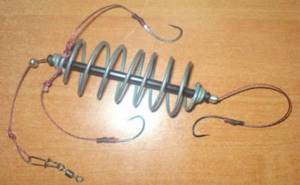
Bait for spring fishing
This feeder requires a more viscous consistency of bait, such as plasticine. The following components can be used:
- crumb of bread
- chopped worms
- wheat, barley or pearl barley porridge
- purchased bait type PRO Sport
- mole ground.
The consistency of the bait plays a very important role, since all types of bait are supported by a spring. If the bait does not have a certain viscosity, it will fly out of the feeder during casting.
As a rule, experienced fishermen have a recipe for such baits, and for a novice fisherman we can recommend one of the quick and affordable recipes:
Homemade bait
- pearl barley – 1 tbsp
- wheat cereal – 1 tbsp
- boiling water – 1 tbsp
- mix and leave for 20 minutes
- After readiness, add 1 tbsp of sunflower cake.
Baits and baits used
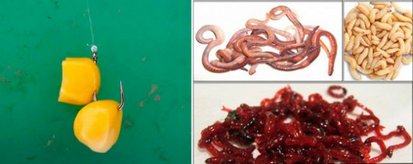
They can be divided into the following categories:
- Vegetable. As such baits, you can use canned green peas or steamed peas, or steamed or canned corn, or wheat.
- Animals. Worms, maggots, bloodworms, and larvae of various insects are suitable for this.
The baits and attachments are selected depending on what the fish prefers at the moment. It is better if you prepare for fishing and stock up on several types of bait.
- For catching grass carp, a good bait would be the king beetle or its larvae, as well as the larvae of the cockchafer.
- Tench's favorite bait is a dung worm.
- It is difficult to find bait for crucian carp if fishing is done in an unfamiliar body of water.
- Carp may prefer canned or steamed corn.
Spring fishing technique
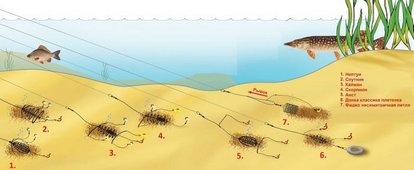
A feeder like a spring can be used with any type of fishing rod. In this case, some features of the use of this type of feeder should be taken into account.
Firstly, the spring is part of the equipment of this tackle and is intended for bottom fishing, regardless of what type of fish is intended to be caught. It can be used both in currents and in still water, while the fishing technique remains unknown. The main role is played by the bait, tightly packed into a spring and slowly dissolving in the water, attracting fish with its smell, creating a food spot in the area of the feeder, partially pulverized in the water column. Thus, the fish are attracted to the feeding area, where the hooks have their favorite baits.
Secondly, the spring is used for catching peaceful fish, such as carp, crucian carp, etc. As a rule, several bottom fishing rods are cast to fish a larger area and increase the chance of catching fish. The gear should be installed at a certain distance from each other so that when fishing, the gear cannot overlap.
Considering the fact that the food is washed out from the feeder quite quickly, you need to check the fishing rods quite often if no bites are observed. When using such equipment, the fish can hook itself, since the feeder has a certain weight, in addition, there is a weight not far from it. Therefore, the chance of catching fish increases. Bites are transmitted to the tip of the rod, therefore, it is desirable that the tip of the rod is not stiff. It is guaranteed that a feeder rod will be suitable for this. Such rods are equipped with tips of different rigidity, therefore, it is not difficult to choose exactly the tip that is most suitable for given fishing conditions. For crucian carp, for example, you can use a softer tip, since the probability of catching a large crucian carp is not high, but when catching such a strong fish as carp, you can take a harder tip, since carp have more strength than crucian carp, and individuals can peck bigger.
“Paternoster” - a simple equipment for muddy bottoms in standing reservoirs
This type of equipment is easy to make and quite effective (detailed article about the paternoster) is suitable for fishing in places with a muddy bottom. For production you will need:
In fact, the “Paternoster” itself can be knitted directly on the main line, many experienced fishermen do this, but beginners are advised to learn how to knit this equipment on a separate line - until you get the hang of it. Let's start making gear.
- We measure a piece of monofilament fishing line 50 centimeters long and cut it off.
- Now we need to fold the piece in half so that one end is 10 centimeters longer than the other.
- We attach a swivel to the folded part using the “cape” method. We attach a feeder to it.
- We measure 10 centimeters from the swivel. We tie a knot.
- We ended up with a large loop with a feeder on one end and tips of different lengths on the other (one 10 and the other 20 centimeters). We knit small loops at the ends.
- We measure out another piece of fishing line 1 meter long. Attach a hook to one end and knit a small loop at the other end.
- Using the “loop to loop” method, we attach the leash to the long end of our loop with the feeder. To attach it to the main fishing line, we knit a similar small loop on it, as on the equipment.
- Using the same “loop to loop” method, we connect the short tip of the tackle to the main fishing line.
Our "Paternoster" is ready.
“Asymmetrical loop” - universal equipment for fishing in still water and in currents
For feeder fishing in still water and in the current, this type of equipment is suitable (more about it and its predecessor). For production we will need:
- monofilament for the main tackle and fluorocarbon for the leader;
- feeder;
- hook;
- two swivels;
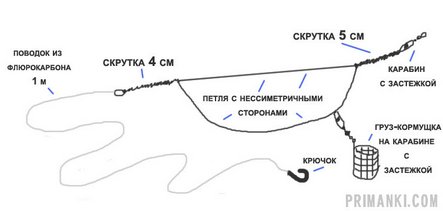
Let's start making gear:
- We measure one meter of monofilament and cut a piece.
- Fold it in half and make a small loop for attaching the leash.
- We measure 10 centimeters from the loop and twist this section of the gear together along the length. We secure the twist using the “surgical knot” method.
- After the knot, measure another 30 centimeters at one end and 40 at the other.
- We put a swivel with a feeder on the long end.
- Now we attach the long end, measured at 40 centimeters, to the short end, measured at 30.
- We tie it with a “surgical knot”.
- We should end up with a loop with asymmetrical halves; on the longer half, the feeder moves freely on a swivel.
- Attach a swivel to one of the remaining ends about 15 centimeters long - it will connect the tackle to the main fishing line.
- Make a leash with a hook on one side and a small loop on the other. Using the “loop to loop” method, connect the leash to the first loop at the beginning of the tackle.
Sports Donka, first steps - feeder guide for beginners.
How to choose the right feeder rod and improve the catchability of your gear by 8 times.
Place bloodworms and maggots on the hook correctly.
Over 7 years of active fishing, I have found dozens of ways to improve the bite. Here are the most effective ones:
- Bite activator . This pheromone additive attracts fish most strongly in cold and warm water. Discussion of the bite activator “Hungry Fish”.
- Increased gear sensitivity. Read the appropriate manuals for your specific type of gear.
- Pheromone -based lures .
Non-sports bottom installations with a feeder
At the end we will talk about two more types of gear:
These equipment are not considered sports equipment, but are nevertheless used by many fishermen. I would like to immediately make a reservation that they are no better than the first three equipment and do not improve in catchability. They are aimed at fishing with coarse gear, for example, with a spinning rod. Although in the article about this donk we recommend using the first 3 rigs on this page. It will be sportier and more efficient.
"Spring-nipple"
The principle of the nipple is based on the fact that the fish simply eats the bait in the feeder and simultaneously swallows the hook hidden in it.
It is not difficult to make this type of gear; we will need:
- A feeder in the form of a spring, or a stopper from a plastic bottle from which a nipple is made (we have a manufacturing guide).
- 2-4 hooks.
- Braided fishing line for leashes.
The process of making a pacifier based on a spring feeder:
- We take a spring feeder and attach it to the main fishing line, secure it with a rubber stopper, a bead or, in extreme cases, a lead pellet.
- Along the circumference of the entire spring, we attach braided leashes 6-7 centimeters long with hooks at an equal distance from each other.
- We advise you to put bait on the hooks, see the specific ones in the guides for crucian carp, carp, bream, and roach. But some anglers equip their hooks with foam balls.
Non-sports equipment is ready. Read more about catching crucian carp with a spring nipple here.
"Makushatnik"
The simplest, but according to some fishermen, catchy tackle for carp and crucian carp is not sporting and is a less effective analogue of the Method Feeder
For production we will need:
- horseshoe or dovetail sinker;
- clasp for leashes, swivel, bead;
- a pair of hooks;
- fishing line 0.4 – 0.6 mm;
Manufacturing instructions:
- We take the fishing line and put a sinker on it, tie a knot.
- After 5–15 centimeters we place a bead for a stopper.
- At the end of the fishing line we attach a swivel to connect it to the main fishing line.
- We make a hole in the center in a piece of cotton wool and thread a fishing line with a knot into it.
- We attach a clasp with leashes to the tip.
- We stick the hooks on the sides into a piece of topcoat.
Metal mesh feeder
A feeder made of metal is definitely one of the most popular types. It’s not that difficult to make, the main thing is to collect a minimum set of tools and materials.
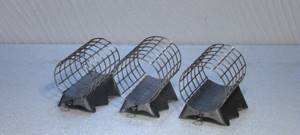
The photo shows an example of serial production of wire feeders.
What do you need:
- Metal mesh, with a cell of 4-6 mm;
- Lead plate;
- Wire;
- Tools: pliers and wire cutters;
- For accuracy: scales.
Manufacturing process:
- We take wire cutters and cut the required mesh size. Using pliers, we bend the mesh into the shape we need: square, triangle or circle.
- Using wire, we fasten the edges of the mesh and tie a load to it, as well as a fastener.
- As for the load (lead), using scales, we take as much of it as is required for a particular type of fishing.
Fishing feeder - easy and simple
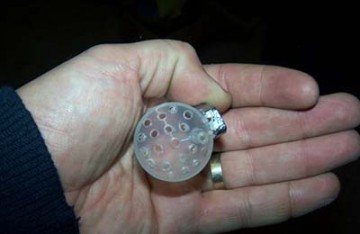
A fishing feeder will significantly improve the results of every trip to a pond with a fishing rod. Due to the lightness of the design, the bait can be thrown as far from the shore as possible. Today there are many different feeders using different materials and shapes.
If you make such a device with your own hands, you can immediately solve two problems:
- Independently create equipment that is not sold in specialized stores;
- Save money;
Varieties and features of their manufacture
The classification of homemade feeders can be made according to several criteria, one of which is the fishing location:
- For fishing in still water. For this purpose, you can choose any shape and one of many materials. The main function of such models will be to deliver bait to the required location. If you need to throw over short distances, you can use lightweight materials. For long-distance casting, feeders must be large in size and heavy in weight;
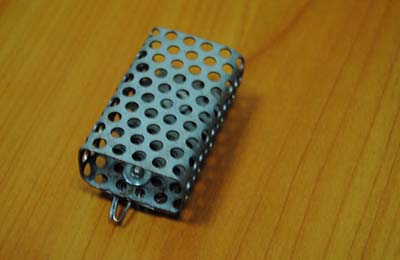
For fishing in bodies of water with current.
Here the main function of the feeder will be to hold the bait point.
To do this, they are made triangular, oval or rectangular. Sometimes, such devices are also equipped with special antennae that resist the flow.
In addition to their shape, these models are also distinguished by their significant weight. To fish on rivers with strong currents, you need a feeder weighing 100-140g. Accordingly, the fishing rod must withstand such a load;
In addition to purpose and shape, such gear can also be divided depending on the materials. Here even specialists and experienced fishermen cannot find a common opinion. Each fisherman has his own signature feeder.
You can construct such things from:
- Steel wire;
- Plastic bottle materials;
- bottle caps;
- Mesh devices;
- Tin and lead;
The choice of model should be made based on your own experience, and if this is not the case, then you need to read about each type of gear and then decide which do-it-yourself fishing feeder is best suited.
Video: How to make a feeder feeder with your own hands
Following the good old tradition, we have prepared for you a selection of videos for those who prefer to watch. They describe in simple and accessible language the process of making feeder feeders not only from the materials listed in the article, but also from something new.
Pipe feeder feeder
An educational video on how to make a simple feeder feeder from scrap materials in a few minutes.
Feeder feeder made from a medical syringe
A very original way with a minimum of tools and materials.
Feeder made from a plastic bottle
One of the easiest ways to make feeder feeder.
Feeder for feeder made from curlers
This is also a simple method, but more dangerous, since you need to persuade your wife to give her the curlers.
Feeder feeder underwater
In this video, the processes occurring at the bottom with a feeder feeder are simulated in an aquarium. The first take with dry bait. In the second take, the same mixture was additionally moistened and you can see how the bait behaves in the feeders in this case. The video features nine different feeders from different manufacturers.
Dear anglers, you can get more information, ask questions to professionals, and chat with beginners in feeder fishing in a special forum thread on our website.
We express our deep gratitude to the Novosibirsk feeder club, and personally to the head of the FRS bottom fishing section - Dmitry Kulmanakov ( angel42 ).
Many fishermen prefer to fish with a feeder and use special feeders for this. They are sold ready-made in special stores, but often people prefer to use homemade feeders for fishing.
It is not always possible to find the right model; in addition, a number of factory-made feeders are not durable. Today you will learn how to make a fishing feeder with your own hands, and also study their varieties.
Wire structures and features of their manufacture
Such products are ideal for fishing on lakes and rivers with weak currents. Wire comes in different types. Therefore, it allows you to prepare feeders of different thicknesses and shapes.
At first it is better to use thin material, this will help you learn how to make feeders correctly.
At the first stage, you need to prepare a metal rod or bolt, this will become the base. You already need to wind the wire onto it. It's easier to do this with pliers. The number of sections should be from 6 to 10.
Then the base is removed and a spring remains, which needs to be given the correct shape. As a result, it should turn out narrow at the edges and wide in the center (like a barrel). You can, again, adjust the shape using pliers or even your fingers. In the center of the spring, you can install and secure with compressed edges a tube through which the fishing line will pass.
Bottle fishing feeder
“>To make such a model yourself, you will need the plastic container itself, a marker, scissors, a ruler, a soldering iron, sheet lead and flexible wire.
The work is carried out in several stages:
- The neck and bottom of the bottle are cut off. The resulting cylinder is cut across and unbent.
- The locations of future holes are marked with a marker. It is recommended to place them in a checkerboard pattern approximately every 2 cm.
- The workpiece is folded back into a cylinder with some overlap. The edges are connected using glue or a stapler. Alternatively, the planes can be heated and joined with a soldering iron.
- The previously marked holes are made with a hole punch, drilled with a drill, or burned with a heated metal rod. To avoid deformation of the material, it is better to perform the procedure using the first two methods.
- A lead plate is adjusted to the shape of the circle of the edges of the workpiece. A reinforcing ring is formed, the edges of which are tightly pressed around the entire perimeter of the plastic.
- If a semi-closed feeder for fishing is required, the sides of the basket are tightened with wire.
Mesh structures and features of their manufacture
Many people call mesh the ideal material for making feeders yourself. Now on the market you can find a lot of mesh materials made of plastic or even metal.
Most often, such things are used during repairs and construction, so it is best to look for them in such places of sale.
Another advantage of this gear is that it can be done even on the shore of the lake, just before fishing. To do this you need a piece of mesh, sheet lead, scissors and wire.
- Step #1. The first stage of work will be cutting out a mesh with a length of 45 and a width of 100 mm. These are standard sizes for such a device. But, depending on the goals, the feeder can be made smaller or larger;
- Step #2. After this, you need to cut a strip of lead with a size of 20x100mm;
- Step #3. The next step is to twist the mesh into the desired shape. The touch line is crimped with a previously prepared lead strip;
- Step #4. Well, in the end, you need to make a fastening from the wire, which will serve as a connection between the feeder and the fishing line;
On "Kormak" in winter and summer
My father and I used this kind of equipment when trolling for perch back in the distant post-war years, and it was called “cormak”: a 5-6-centimeter leash is tied 10-15 centimeters from the spoon, and a hook is attached to it.
Hooks - in the range No. 6-10, depending on the size of the spoon. A bunch (usually 1-3) of red woolen threads is attached to the bend of the hook with a black nimble thread. When trimmed, the threads are left with small ends - “tendrils”. In general, it turns out something like an exotic insect. The hook of the spoon itself can also be equipped with threads.
As practice has shown, it is better to use a double hook instead of a single hook. In this case, the threads are attached to each hook hook separately and tied to a common shank. I have repeatedly tried to tie a tee to the leash, but a double works better: the predator takes it into its mouth more freely and is reliably caught. There are practically no gatherings. Instead of red woolen threads, you can attach pieces of foam rubber, leather from old gloves, cloth, or other similar material of red, black, gray or red color to the hooks.
“Cormak” can be modified and presented in a different version. Instead of artificial materials, small dung worms, pieces of large worms, two or three jigs pre-treated with boiling water are placed on the hooks of the spoon and additional leash (the crustacean then turns red). If you don’t have such bait at hand, you can attach a fish eye, an anal fin with part of the skin from a perch, roach and other small fish with red fins, and even pieces of the fish itself to the hooks.
“Cormak” has proven itself well when catching not only predators, but also purely peaceful fish - roach, ram, dace, carp, carp and even crucian carp.
In the Far North, I successfully caught grayling, vendace, whitefish and other fish using kormak. In the Baltic Sea - cod, eelpout, on the Black Sea - horse mackerel, sea bream, mullet and even a small red mullet fish. The whole secret was that the tackle was selected according to the fish (size of spinners, hooks and line diameter). By the way, in the “kormak” instead of a spinner, you can use jigs of various colors and configurations. Mormyshki, as a rule, are used when catching medium and small fish. Bites are observed on both the jig and the bait.
You can also fish with “kormak” in the summer in river bays with or without a quiet current, in pits, lakes, reservoirs, in the sea, from a boat, other floating craft, from a pier - in a plumb line.
A good summer bait in such cases is barley shell meat, or even better - crayfish meat (on a large “cormak”, when catching large fish, you can hook whole small crayfish onto hooks).
At sea, instead of simple worms, it is better to use sea worms, as well as the meat of shrimp or the fish themselves. I caught many sea fish using pieces of salted anchovy or herring. Well, now a few words about the glittering technique. The fisherman periodically briefly twitches the fishing rod (the twitching speed is different for different fish), raising the tackle no higher than ten centimeters from the bottom. High and sharp lifting of the tackle makes the bait play unnatural and only scares away the fish.
V. Kopylov “Aqua-Hobby No. 1 - 1994”
